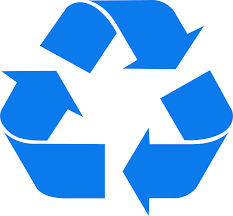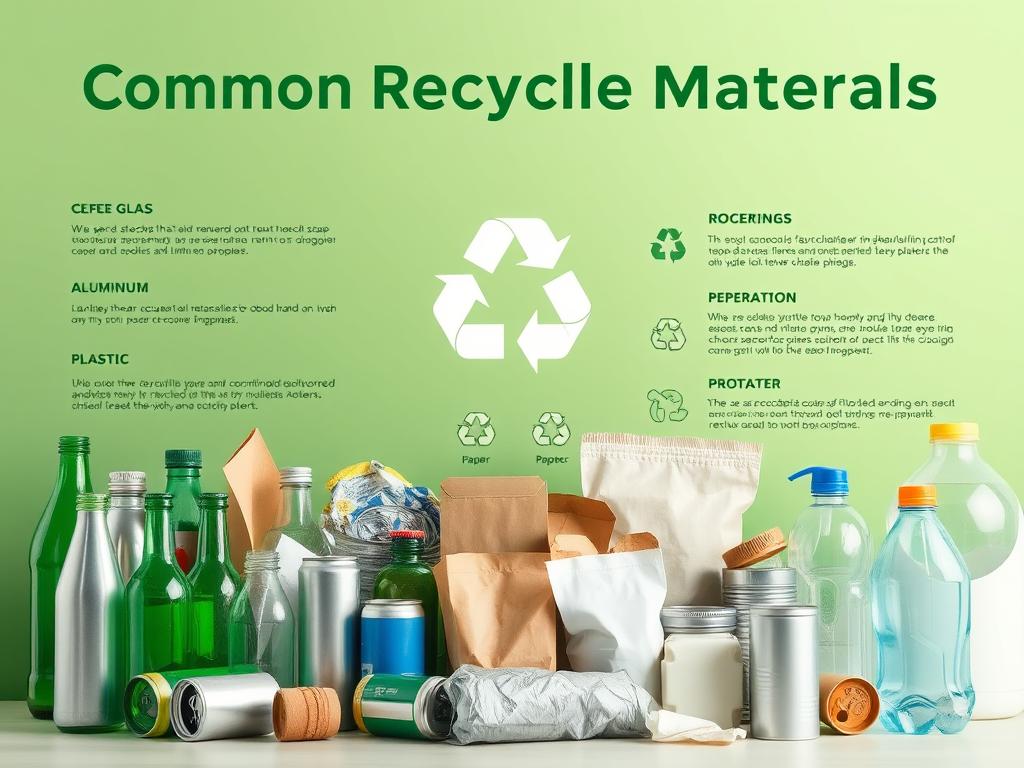Recycling is vital for sustainable waste management in the United States. Americans recycled 69 million tons of waste in 2018. This shows a growing commitment to environmental conservation.
Knowing recyclable materials is crucial for sustainable waste management. Paper, cardboard, metals, and plastics are key to most recycling programmes. The comprehensive recycling landscape shows these materials can significantly reduce landfill waste.
Recycling’s impact goes beyond waste reduction. Aluminium cans can return to shelves in just 60 days after recycling. This process saves 95% energy compared to producing new cans from raw materials.
Curbside recycling programmes accept various materials. These include paper, cardboard, glass bottles, rigid plastics, and metal containers. By taking part, you can support sustainable waste management.
Knowing what to recycle is key to effective waste reduction. Our guide explains common recyclable materials and their processing. It also highlights the environmental benefits for communities across the United States.
Understanding Recycling Basics and Environmental Impact
Recycling safeguards our planet and conserves natural resources. It creates significant economic and ecological benefits for communities across the United States. The impact extends far beyond simple waste management.
The Current State of Recycling in America
The US recycling landscape presents both challenges and opportunities. Recent data reveals some striking insights:
- Only 30% of recyclable waste is actually recycled nationally
- Recycling and reuse activities generate 681,000 jobs annually
- The industry contributes $37.8 billion in wages and $5.5 billion in tax revenues
Environmental Benefits of Recycling
Recycling delivers substantial environmental benefits. It reduces greenhouse gas emissions and conserves resources. Different materials show remarkable recycling potential:
| Material | GHG Reduction |
|---|---|
| Aluminum | 96% reduction |
| Steel | 87% reduction |
| Glass | 41% reduction |
| Paper | 37% reduction |
Energy Conservation Through Recycling
Recycling benefits extend to significant energy savings. Recycling one ton of materials can generate $65.23 in wages and $9.42 in tax revenue.
Community recycling programmes are vital for improving waste management efficiency. Proper sorting and education are key to maximising recycling potential.
Understanding recycling basics helps individuals make informed choices. These choices support sustainable practices and contribute to global conservation efforts.
Paper and Cardboard Recycling: Leading the Way
Paper recycling is vital for managing waste. In 2018, the US generated 67.4 million tons of paper waste. The recycling rate was an impressive 68.2%.
Recycling paper brings huge environmental benefits. One ton of recycled paper can save 380 gallons of oil and 7,000 gallons of water. It also saves 17 trees and powers an average American home for six months.
- 380 gallons of oil
- 7,000 gallons of water
- 17 trees from being cut down
- Enough energy to power an average American home for six months
Cardboard recycling excelled with a 91.4% rate in 2021. Nearly 80% of US paper mills now use recycled paper. This shows the industry’s strong commitment to sustainability.
| Year | Paper Waste Generated | Recycling Rate |
|---|---|---|
| 2018 | 67.4 million tons | 68.2% |
| 2021 | Estimated 65 million tons | 91.4% (Cardboard) |
The recycling sector keeps innovating. The American Forest and Paper Association plans $4.1 billion in manufacturing investments from 2019 to 2023. These funds will boost recovered fiber use.
“Recycling is not just about waste management; it’s about resource conservation and sustainable future,” says industry expert.
Paper recycling is key to environmental sustainability. The US aims for a 50% overall recycling rate by 2030.
What Are Recyclable Materials?
Recycling is vital for our environment and resources. Knowing what can be recycled helps us make better choices about waste and sustainability.
The recycling world is vast and intricate. About 75% of waste could be recycled, but only 30% actually is. This gap shows why we need to know more about recyclable materials.
Primary Categories of Recyclable Materials
Recyclable materials fall into several main groups:
- Paper and Cardboard
- Plastics
- Metals
- Glass
- Organic Waste
Material Identification and Sorting
Good recycling starts with proper sorting. Each type of material needs specific handling to avoid contamination and boost efficiency.
| Material Type | Recyclability | Recycling Rate |
|---|---|---|
| Paper | 67% (untreated) | 66% in 2020 |
| Aluminum | 100% Recyclable | 50% Recycling Rate |
| Plastic | Varies by type | 9% Globally in 2021 |
| Glass | 100% Recyclable | 35% in 2018 |
Contamination Prevention Guidelines
Preventing contamination is crucial in recycling. Contaminated materials can render entire batches unrecyclable, reducing the effectiveness of recycling efforts.
Key guidelines include:
- Clean all recyclable materials before disposal
- Remove food residue from containers
- Separate different types of materials
- Avoid mixing non-recyclable items with recyclables
By recycling properly, we can cut down on waste. This helps create a more sustainable world for everyone.
Metal Recycling: Aluminium and Steel
Metal recycling turns discarded materials into valuable resources. Aluminium and steel are perfect for continuous recycling. This practice offers significant environmental and economic benefits.
Metal recycling’s potential is truly remarkable. Here are some fascinating insights:
- 90% of all refined metal today is iron
- Steel items often contain 25-100% recycled content
- Aluminium cans require just 5% of the energy to recycle compared to virgin production
The Infinite Recycling Potential of Metals
Metals can be recycled indefinitely without losing quality. Steel and aluminium can be reprocessed multiple times. They maintain their structural integrity and performance characteristics throughout.
Processing Methods and Applications
Metal recycling uses advanced processing techniques. Aluminium cans melt at about 700°C, while steel needs 1700°C. These methods create new products for various industries.
From construction to automotive manufacturing, recycled metals find diverse applications. This process transforms scrap metal into valuable resources.
Economic Benefits of Metal Recycling
Metal recycling offers substantial economic advantages. Recycling steel saves 75% of energy compared to primary production. This reduces manufacturing costs and conserves natural resources.
Every ton of recycled steel saves 2,500 pounds of iron ore. It also significantly reduces carbon emissions, benefiting the environment.
Recycling metals isn’t just an environmental strategy—it’s an economic opportunity.
Industries can reduce waste and conserve energy through metal recycling. This creates sustainable production cycles, benefiting both businesses and the environment.
Glass Recycling: Breaking Down the Process
Glass recycling offers a unique chance for sustainable materials management. It can be recycled endlessly without losing quality. In the United States, about 37% of container glass is recycled.
The glass recycling journey involves several key stages:
- Collection from residential and commercial recycling bins
- Sorting and separating by colour and quality
- Cleaning to remove contaminants
- Crushing into small pieces called cullet
- Melting and reforming into new glass products
Glass recycling faces challenges, with contamination rates between 50-60%. Yet, the environmental benefits are huge. For every ton of glass recycled, over a ton of natural resources is saved.
These resources include:
- 1,300 pounds of sand
- 410 pounds of soda ash
- 380 pounds of limestone
The economic impact is also impressive. Recycling glass creates more than 8 jobs per 1,000 tons processed. Manufacturing costs drop by 2-3% for every 10% of cullet used.
Carbon dioxide emissions are cut by one ton for every six tons of recycled glass. New ideas and greater public awareness can boost recycling rates for a greener future.
Plastic Recycling: Types and Classifications
Plastic recycling is a crucial environmental challenge today. Plastic resin codes help us make better recycling choices. These codes are vital for consumers and industries alike.
There are seven distinct types of plastic globally. Each type has its own recycling traits. Not all plastics can be recycled equally.
Understanding Plastic Resin Codes
Plastic resin codes help identify different plastic materials. These codes provide key info about recycling potential. They use numbers to classify plastics.
- PET (Polyethylene Terephthalate): Most widely recycled plastic globally
- HDPE (High-Density Polyethylene): Highly recyclable material
- PVC: Rarely recyclable
- LDPE (Low-Density Polyethylene): Limited recycling options
- Polypropylene: Challenging to recycle
Common Recyclable Plastic Items
Some plastic items are easier to recycle than others. Soda bottles, milk jugs, and laundry detergent containers are among the most recycled plastics.
| Plastic Type | Recycling Rate | Common Uses |
|---|---|---|
| PET | 31% (US) | Beverage bottles |
| HDPE | 30% | Milk jugs, containers |
| Polypropylene | 1-3% | Food containers |
Challenges in Plastic Recycling
Plastic recycling faces big hurdles. In 2018, only 8.7% of US plastic waste was recycled. Contamination and mixed plastics are major issues.
Limited recycling infrastructure also hinders effective plastic recycling. These factors create substantial barriers to progress.
The ocean bears the brunt of our plastic waste, with approximately 75% of marine plastics originating from land-based sources.
Commercial and Industrial Recycling Materials
Industrial recycling is vital for sustainable waste management. Steel leads as the most recycled material globally. Each year, 70 million tons of domestic scrap become new steel.
Commercial recycling now includes a wide range of materials. This allows businesses to significantly reduce their environmental impact. Many sectors are developing comprehensive waste management approaches.
Paper and cardboard make up 23% of small business waste. This presents great opportunities for commercial recycling. Large industrial facilities can use specialised recycling containers of various sizes.
Single stream recycling is a convenient solution for many organisations. It allows collection of multiple approved materials together. Advanced sorting technologies help reduce contamination risks.
Strategic recycling efforts conserve valuable resources. Materials like glass and plastics can be repeatedly transformed into new products. This approach reduces landfill volumes and preserves natural resources.
Modern industrial recycling goes beyond traditional materials. It now includes electronics, industrial oils, and complex waste streams. Targeted recycling programmes offer multiple benefits for businesses.
These programmes can reduce environmental footprint and decrease disposal costs. They also contribute to a more sustainable economic model. Businesses can make a real difference through effective recycling strategies.


